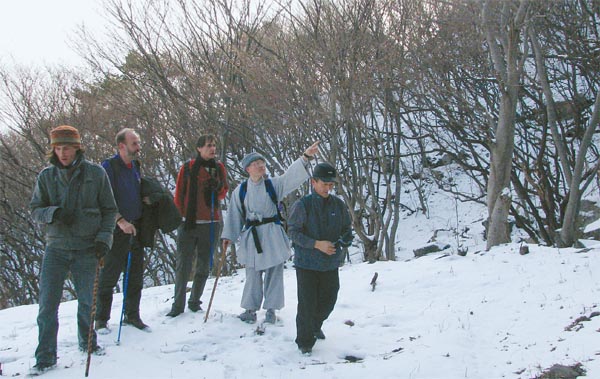Expats carve paths for Wonhyo project

A group of expats and their Korean supporters pause for a break during their first exploratory hike along a trail they hope to develop into a pilgrimage route. The project to develop the prospective route, which spans more than 500 kilometers (310.7 miles) from Gyeongju, North Gyeongsang, to Dangjin, South Chungcheong, is called Footsteps of Wonhyo after the renowned Korean monk of the same name. Provided by the group
A group of expats is working on an ambitious project to develop a pilgrimage emulating Spain’s El Camino de Santiago.
The group hopes to establish a trail that follows the route used by the renowned Korean monk Wonhyo (617-686), who in the 7th century set off on a journey that ultimately led to his enlightenment.
The walk is part of a larger project, already six years in the making, called Footsteps of Wonhyo.
Last month, the group completed its first exploratory walk along the route, traveling more than 500 kilometers (310.7 miles) from Gyeongju, North Gyeongsang, to Dangjin, South Chungcheong.
“In a way, it is a historic event because it’s never been done before - not once in 1,300 years,” Tony MacGregor, a 66-year-old Canadian who initiated and is leading the project, said in reference to the walk he and friends took from Dec. 4 to 18.
MacGregor said the first walk was useful in helping the group find paths that could potentially be developed into a walking trail.
The first walk will be documented in a book, he said, adding that they hope to do another exploratory walk this year to further map out the route.
“It is an important event, in terms of attracting people to Korea for cultural and spiritual reasons,” MacGregor said. “By following in the footsteps of a teacher who reached the ultimate level of self-understanding, participants will have a great opportunity for their own self-discovery.”
Wonhyo, who lived in the late Silla Dynasty (57 BC?935), is one of the most renowned Buddhist scholars in Korean history. He is best known for his oneness philosophy and his teaching that truth is found in the mind.
Legend has it that he realized that truth when he was on a journey to study in China, which was a regional center of Buddhism at the time. One night, he took shelter from a storm in a cave and thirstily gulped down some water, which tasted delicious at the time, only to realize the next morning that it was rotten brackish liquid contained in a human skull. This action brought him to the realization that the mind determines the difference between truth and reality.
That incident led him to abandon his plan to go to China. Instead, he focused on spreading the Buddha’s teachings in Korea, which was largely a Buddhist country. Wonhyo’s teachings also attracted followers in China, Japan and other Asian countries.
In discussing Wonhyo’s experience, Korean history textbooks stress his sudden enlightenment rather than the journey he took beforehand. Historical documents conflict on the path he took and the exact route he followed on his journey remains unknown.
The expat group maintains that Wonhyo’s long walk was important and could have played a role in his enlightenment.
“When you are walking that amount of time, for Wonhyo it was many weeks, it can have impact on your thinking,” MacGregor said. “Hiking can create openness to spiritual change.”
He said that since nobody knows the exact route Wonhyo walked, the path he and his group took is only an approximation of the original route.
But MacGregor said that he believes the spiritual aspect of the journey is more important than the exact physical trail. He said the beautiful scenery and people’s hospitality will remain the same, providing visitors with a unique, inspiring experience.
In the early stages of the project, the expat group reached out to the government for help and was met with an enthusiastic response.
In January 2009, the Ministry of Culture, Sports and Tourism, the Korea Tourism Organization and the Sustainable Tourism/Eliminating Poverty Initiative, a Seoul-based affiliate of the UN World Tourism Organization, held a ceremony marking the launch of a multi-year project to develop a “world-class tourist package” encompassing a walking trail and a temple stay linking around 470 Buddhist temples along the route. But the project fizzled out.
Citing an unidentified official from the culture ministry, SBS said in a Sept. 17, 2011 report that the project had been halted in July 2010 based on a commissioned study that said too many sections of the potential route were covered with vehicular roads for it to be restored as a hiking trail. SBS also said the government had planned to put 15.6 billion won ($13.4 million) into the project by 2016.
An official of the Korea Tourism Organization told the Korea JoongAng Daily last week that the project is not on the organization’s current agenda.
MacGregor said he sent an e-mail to KTO President Lee Charm after that first exploratory walk, asking for a meeting about the project, but so far nothing has been arranged.
He said that many expats have said they hope the government will support the project and involve expats in its planning.
“Perhaps this is an example of foreigners having better eyes than Koreans when it comes to tourism,” said a person with the user name “R. Elgin,” on the Marmot’s Hole, a well-known blog about Korea. “So far, Korean bureaucrats have done a poor job of internationally promoting their own country, so maybe giving foreigners the power to determine and execute tourism concepts might be a wise idea.”
By Moon Gwang-lip [joe@joongang.co.kr]










with the Korea JoongAng Daily
To write comments, please log in to one of the accounts.
Standards Board Policy (0/250자)